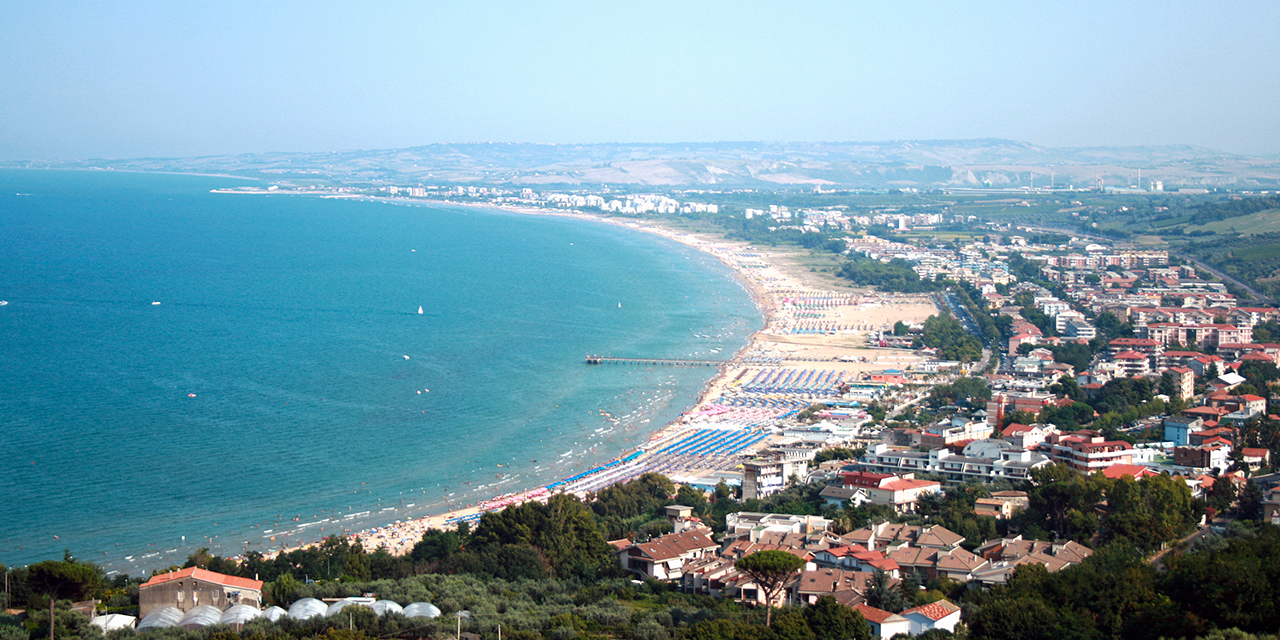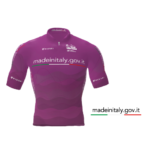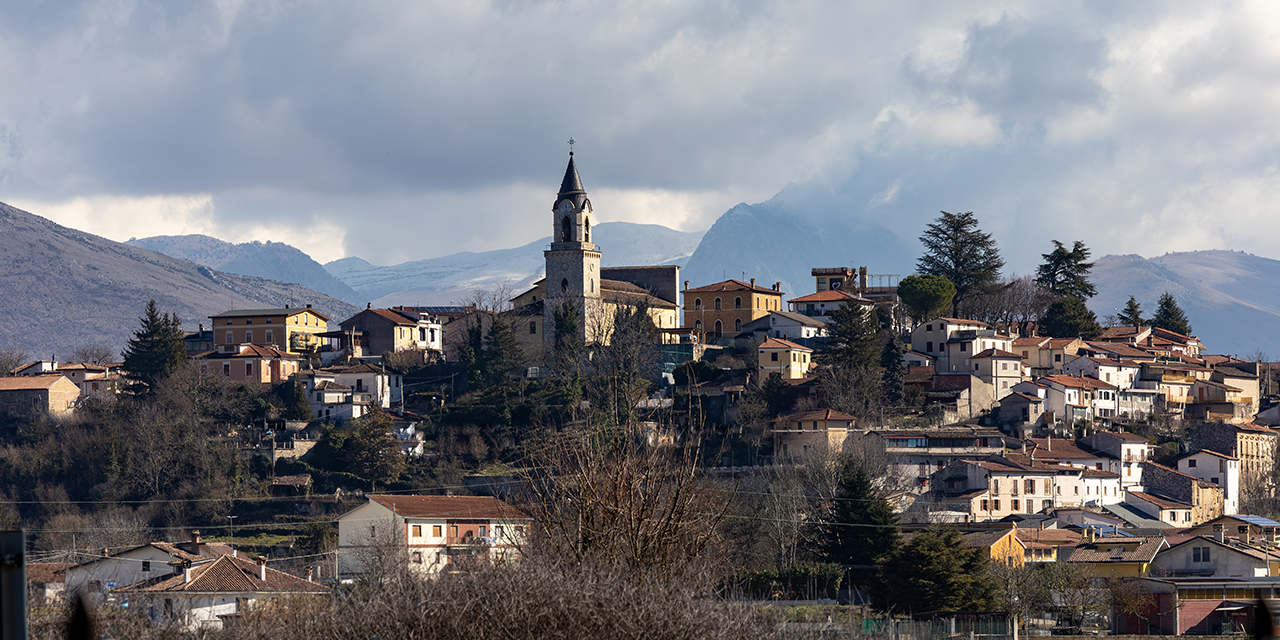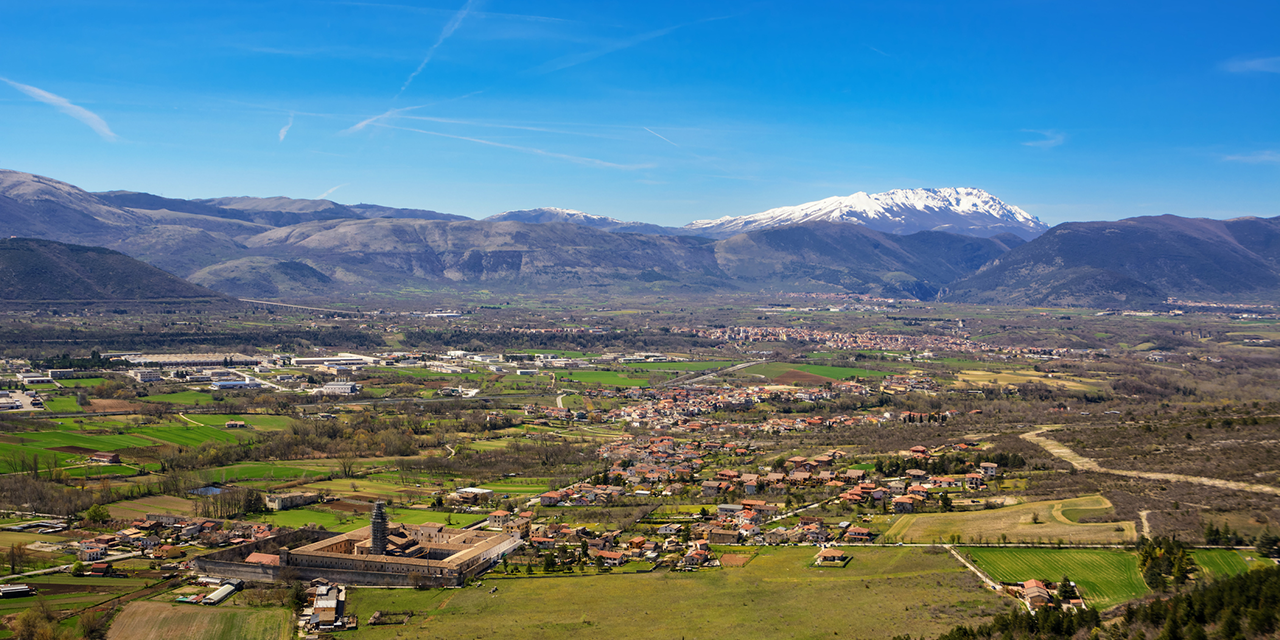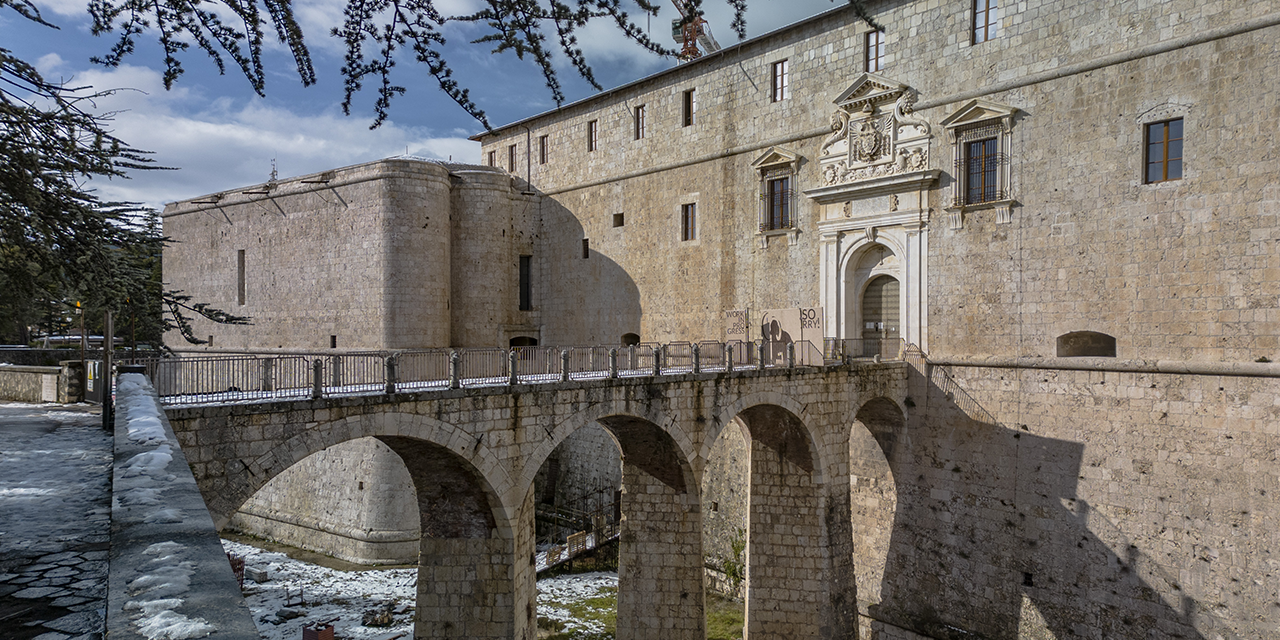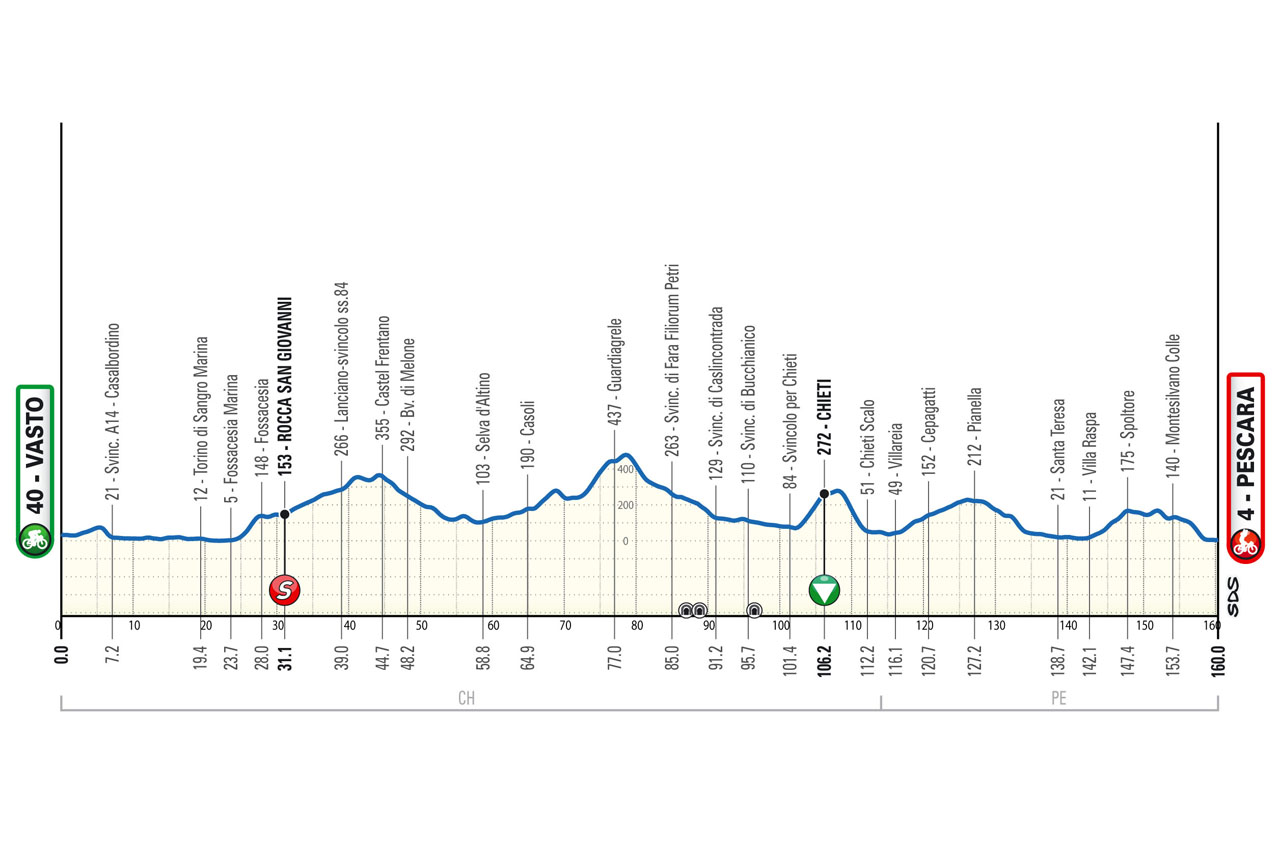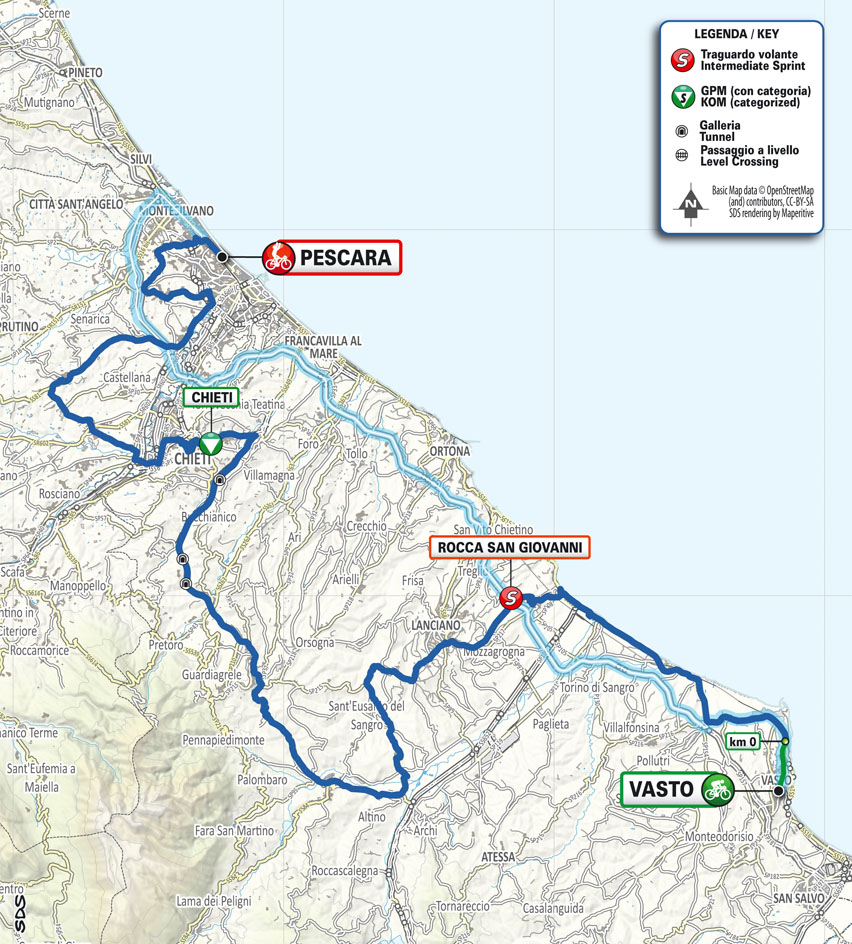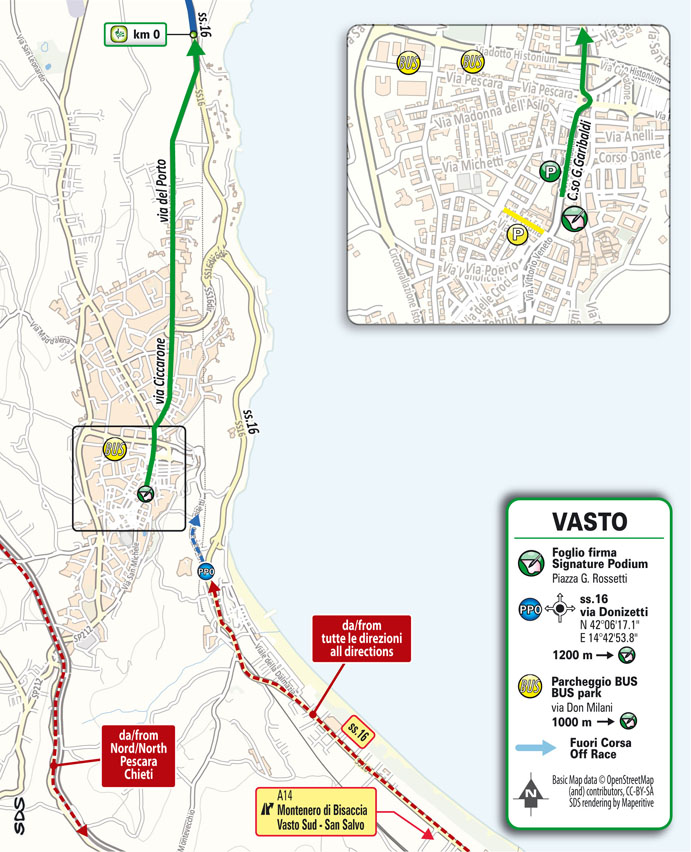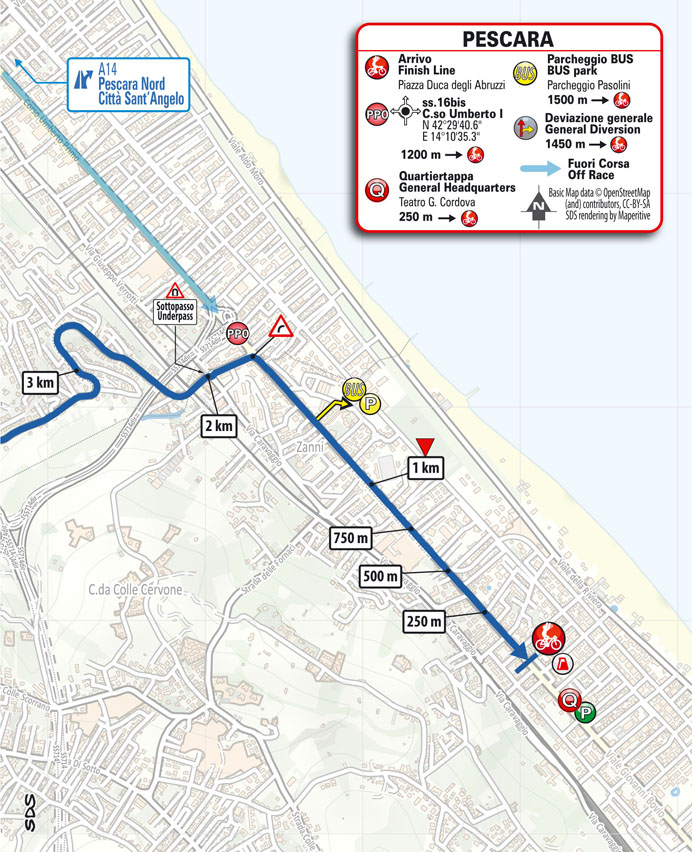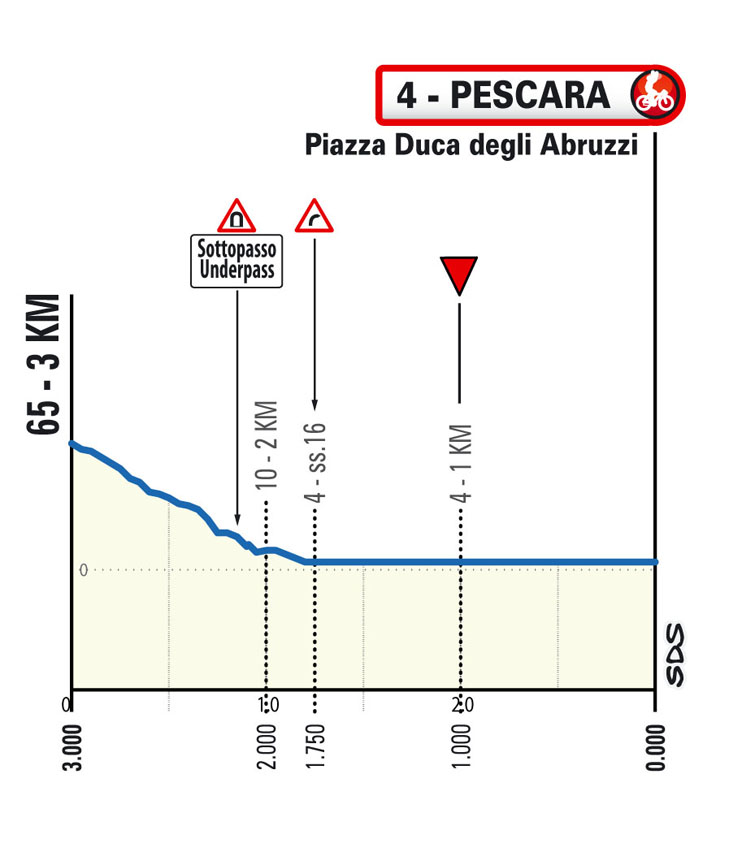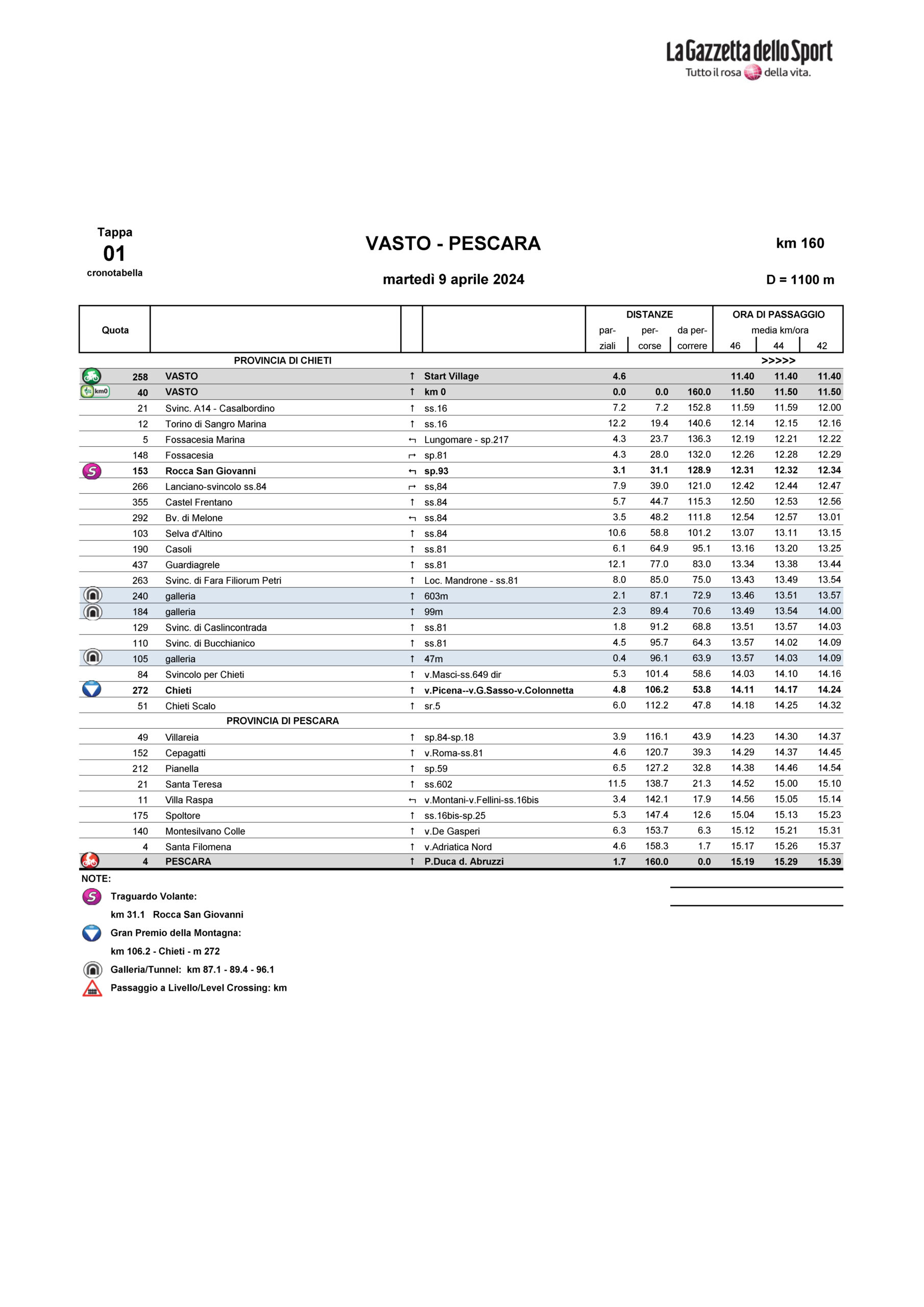learn more
technical info
profile
map
technical info
Hilly stage with a downhill finish towards the Adriatic coast. The first part features a series of ups and downs in the province of Chieti after a short stretch along the coast. The riders will then tackle the short climbs of Fossacesia, Castel Frentano and Guardiagrele before arriving in Chieti. The second, less demanding part features the climbs of Pianella and Spoltore. The peloton will travel along slip roads, crossing urban areas with the usual traffic obstacles (roundabouts, speed humps and traffic dividers).
Last km
The last kilometres are partly downhill (with a railway subway to be crossed) and then perfectly flat on the final 1700m straight on asphalt (8 m wide).
start / finish
final kilometres
itinerary timetable
tourist info
Host city:
VASTO
Overview
Vasto is one of the most fascinating town of Abruzzo, on the Adriatic Sea with its characteristic gulf and protected by the Apennine peaks, beautiful in its uniqueness.
The coast of Vasto stretches for over 17 Km, with beaches of different types: from the fine and golden sand of Vasto Marina and Punta Penna, to that of pebbles and rocks of Mottagrossa and San Nicola. Every tourist can choose the most desired beach between coves and headlands and taste the seafood specialty on the trabocchi, the ancient wooden fishing machines positioned in the middle of the sea. You can enjoy the seascape by staying at the seafront of Vasto Marina, full of bathing establishments equipped with every comfort and admire the symbol of the city in the middle of the sea, the Bagnante’s monument.
Food
The cuisine of the Vasto area, from the coast to the hinterland, is renowned for its variety, thanks to the different traditions that have participated in its birth and growth. The shepherds’ cuisine mixed with that of the farmers and their mountain products characterized by simple dishes but, at the same time, tasty. Therefore, wide use of soups and minestre, sheepmeat, cheese and that extra flavor given by aromatic herbs.
A separate note should be made for the seafood cuisine, facilitated by a catch of great quality and variety and from the great heritage “of the earth” such as vegetables from the nearby hills, and it is precisely from the meeting of these products that the main dish of the tables is born: fish soup Vastese style.
Beverages
In the vastese cuisine, the use of oil and the taste of a good dish wine are of vital importance. The agricultural economy of Vasto is mainly based on wine and oil. Quality products, certified by the various denominations and indications of origin such as the PDO extra virgin olive oil and Montepulciano d’Abruzzo, Cerasuolo, Trebbiano Doc and Pecorino wines.
Points of Interest
D’Avalos Palace
Overlooking the sea and symbol of the city, Palazzo d’Avalos dominates the landscape with its majesty and its Neapolitan garden. It is one of the most significant examples of Renaissance architecture in Abruzzo from the second half of the sixteenth century in Roman style, built on pre-existing Roman and early medieval structures, which incorporated the remains of the fifteenth-century building built by the Caldora and devastated during the incursion of the Turkish armies of Pialy Pascia in 1566. During the three centuries of lordship of the d’Avalos, from the end of the fifteenth century until the French occupation of 1799, the building gradually took on the appearance of a palace, seat of a real small local court. After the d’Avalos abandoned it, the rooms of the palace were progressively divided up to obtain apartments and shops, transformations for utilitarian purposes which ended up obscuring the princely residence. In 1974 the Municipality of Vasto completed the acquisition of the Avalos share and the restoration work on the complex began. It houses four museums: the Archaeological Museum, which documents the history of the city and the territory, the Pinacoteca, with the works of the family of painters of Filippo Palizzi, a participant in the most important artistic currents of the 19th century, “Mediterranean”, the collection of Contemporary Art with works by Italian and Spanish artists, and the Museum of Ancient Costume, which includes a collection of paintings depicting traditional clothes and a collection of Abruzzo clothes from the early 1800s and early 1900s. The building is also known for the presence of the spectacular Neapolitan garden, overlooking the sea, brought back to its former glory by a restoration that has returned it to the original late eighteenth-century layout. The complex also has halls and rooms set up and used for events and temporary exhibitions.
Caldoresco castle
The Caldoresco Castle was built in 1439 by the Sienese architect Mariano di Jacopo known as Il Táccola on commission from Giacomo Caldora, the feudal lord and lord of Vasto. The castle is located in the historic center of the city and overlooks Piazza Rossetti and Piazza Barbacani. The square plan has four almond-shaped angular bastions (today one is missing), and a larger circular watchtower full of merlons, and a smaller side tower, transformed in the eighteenth century. The bastions have lanceolate towers, with a low body without openings on a scarp base, with an intermediate frame, and pointed arches.
Roman thermal baths
The thermal complex of Vasto, the ancient Histonium, is the largest in the entire Adriatic area of central-southern Italy: in fact, it has an area of about 250 square metres. Furthermore, much of the site is still buried under the nearby Adriatic road and the church of Sant’Antonio.
Piazza “Gabriele Rossetti”
The area of the ancient Roman amphitheater of Histonium, was built around 1924, since before it was only a dirt clearing for the market. It has a semi-elliptical appearance, following the shapes of the amphitheater, with the monument to the poet Rossetti in the centre, surrounded by four large palm trees. The small houses of the Santa Maria Maggiore district, the Palazzo Palmieri, the church of San Francesco di Paola, and the southern access to Corso Italia overlook the square.
Loggia Amblingh
It takes its name from the secretary of the Palazzo d’Avalos Guglielmo Amblingh, and is the panoramic promenade of the Santa Maria Maggiore district, which includes the stretch of the walls with tower-houses, including the Casa Rossetti, the descent to Fonte Jovine, the chapel of the Madonna della Catena, and the entrance to the district from Porta Santa Maria. The loggia is broken by the retaining wall of the garden of Palazzo d’Avalos, which forces you to go up towards Piazza Pudente, while at the other end you go up to Piazza Cavour.
Rossetti Theatre
The main theater of Vasto is the Teatro “Gabriele Rossetti”, located on the edge of the historic centre, in the Porta Nuova area. The theater was built in 1819 above the old monastery of Santo Spirito, designed by Taddeo Salvini. The works, interrupted, were completed in 1830, with the solemn inauguration of the theater on 15 September 1832 in the presence of King Ferdinand II of the Two Sicilies. At the curtain the Histonese Roman poet Lucio Valerio Pudens was depicted, crowned in Rome with the laurel. In 1841 the Real Teatro Borbonico required maintenance works, and the intervention was entrusted to Pietrocola. In September 1909 the works on the building were definitively completed (carried out by the engineer Filippo Laccetti), which appears as a typical Italian opera house, with a neoclassical facade.
Natural Reserve of Punta Aderci
The protected area is the first Reserve established in Abruzzo in the coastal strip and was born from the need to reconcile the naturalistic aspect of the area with the tourist one, relating to the usability of the beaches. The Reserve has an extension of about 285 hectares (which reach 400 with the external protection area) and goes from the beach of Punta Penna, adjacent to the Port of Vasto (Punta della Lotta), to the mouth of the river Sinello (border with the municipality of Casalbordino). The long sandy beach of Punta Penna ends with the pebble beach of Libertini below the cliff of the promontory of Punta Aderci. The Libertini beach is accessible both from the Punta Penna beach and via a short path of 80 steps, which connects it to the dirt road that leads to the promontory of Punta Aderci (26 m a.s.l.). On the other side of the promontory is the small beach of Punta Aderci. From here continue to the long pebble beach of Mottagrossa. From this beach to the mouth of the Sinello river begins one of the most solitary and difficult to access stretches of coast of the central Adriatic. Overlooking the Mottagrossa beach, take a panoramic route at high altitude (about 20m above sea level) of about 3 km (former railway track) which allows you to discover the pine forests by the sea, valleys and stretches of Mediterranean scrub on foot or by bike. The pine forests offer the visitor the possibility of a refreshing break during the summer months. The Reserve ends at the mouth of the Sinello river, just beyond the characteristic brick arches that delimited the old railway line. Turning left, just before the mouth, you move away from the coast along a path that runs alongside the Sinello river and crosses the internal area of the Reserve. Due to the high summer temperatures and the length of the route, this section of the trail is best visited by mountain bike.
PESCARA
Videos Stage 01
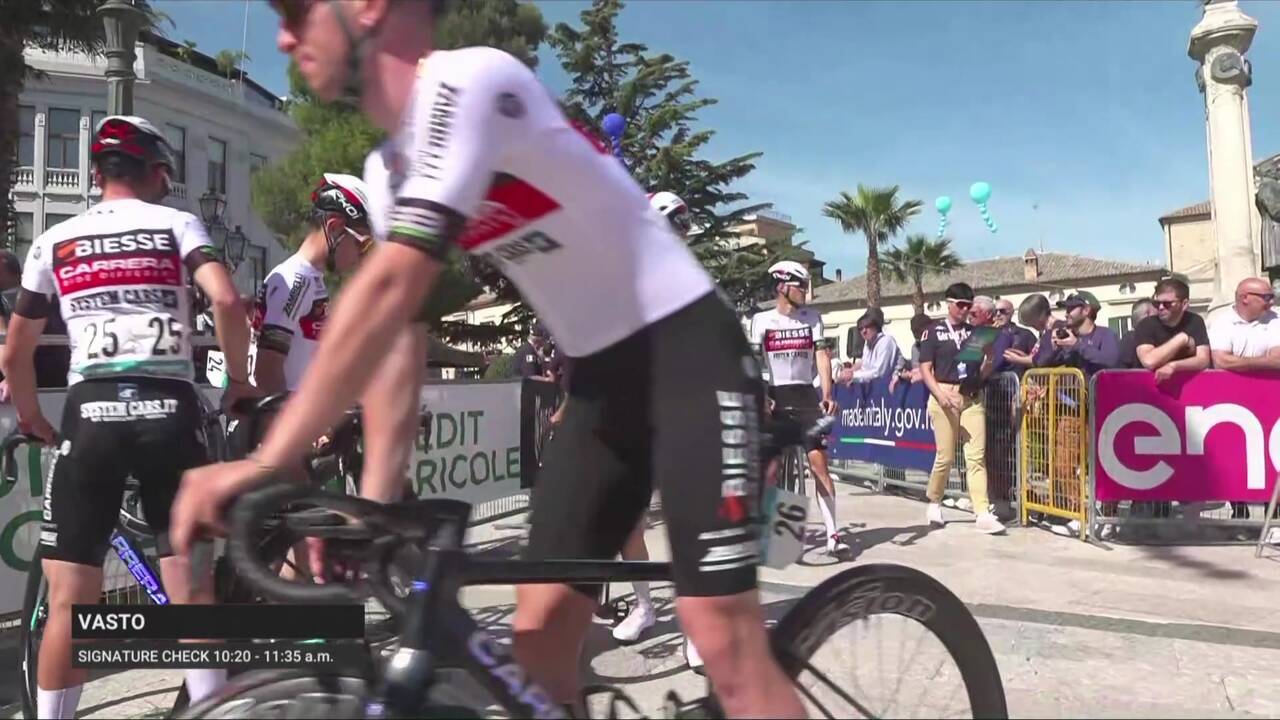
Tirreno-Adriatico Crédit Agricole 2024 | Stage 1 | Highlights 🇬🇧
9 Apr 2024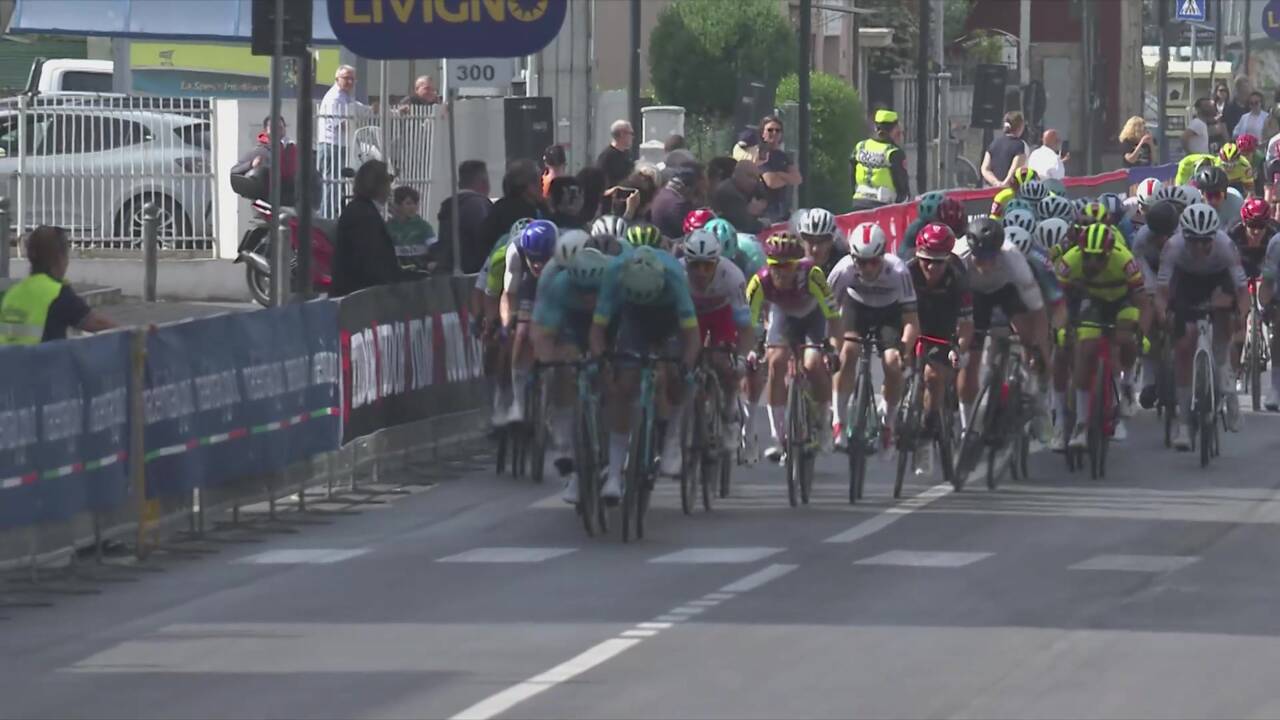
Il Giro d'Abruzzo Crédit Agricole 2024 | Stage 1 | Last KM 🇮🇹
9 Apr 2024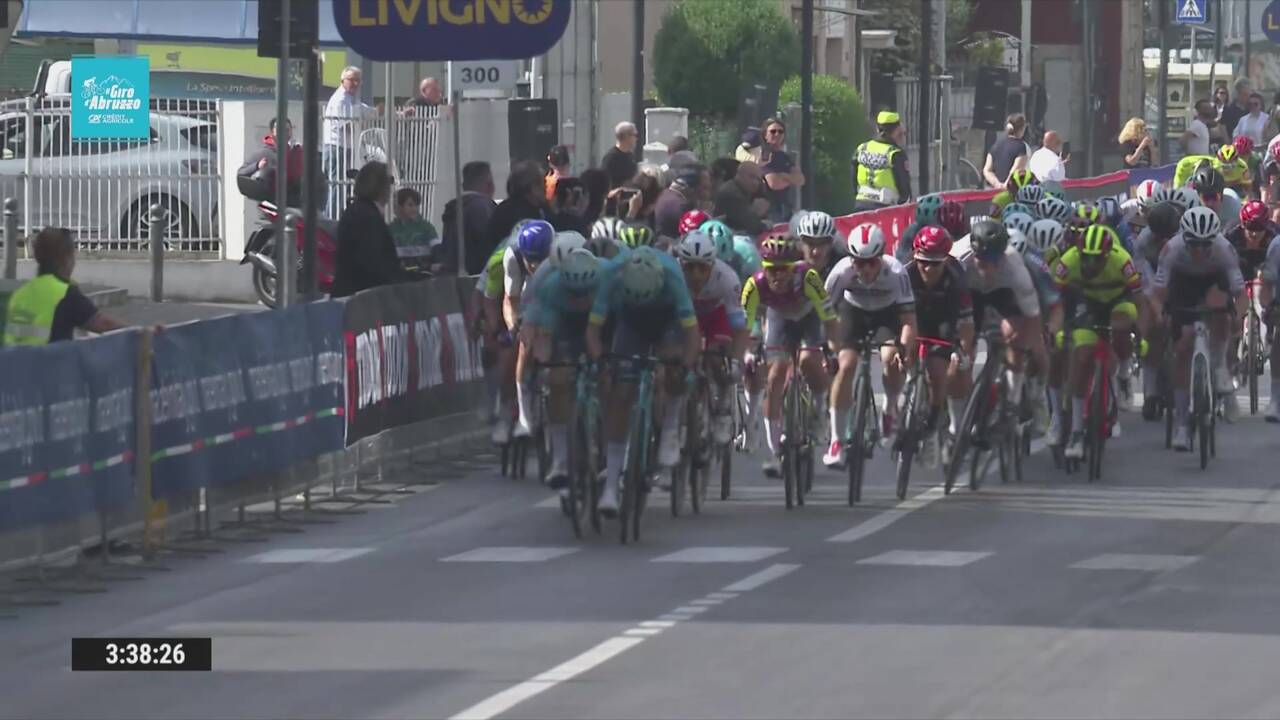
Il Giro d'Abruzzo Crédit Agricole 2024 | Stage 1 | Last KM 🇬🇧
9 Apr 2024

